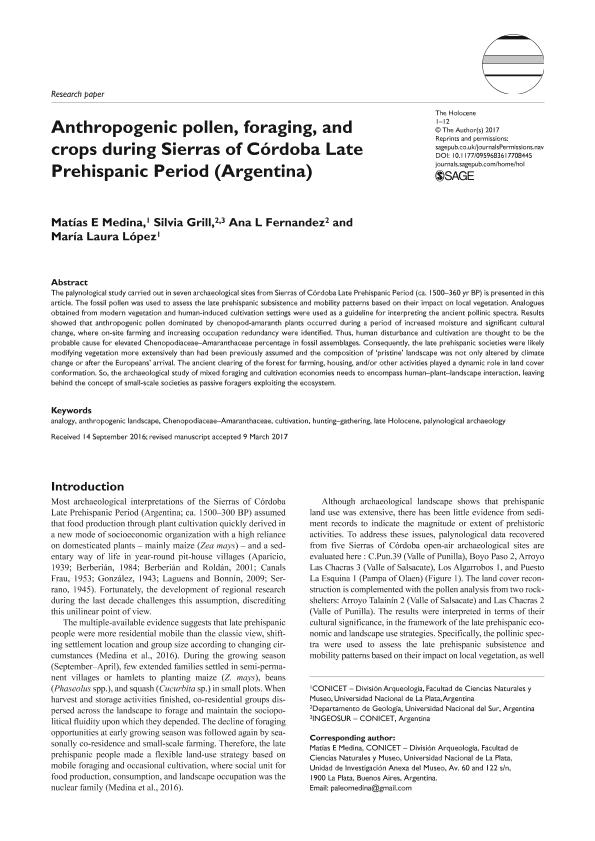Mostrar el registro sencillo del ítem
dc.contributor.author
Medina, Matias Eduardo

dc.contributor.author
Grill, Silvia Cristina

dc.contributor.author
Fernandez, Ana L.
dc.contributor.author
Lopez, María Laura

dc.date.available
2018-08-24T19:35:11Z
dc.date.issued
2017-11
dc.identifier.citation
Medina, Matias Eduardo; Grill, Silvia Cristina; Fernandez, Ana L.; Lopez, María Laura; Anthropogenic pollen, foraging, and crops during Sierras of Córdoba Late Prehispanic Period (Argentina); Sage Publications Ltd; Holocene (Seven Oaks); 27; 11; 11-2017; 1769-1780
dc.identifier.issn
0959-6836
dc.identifier.uri
http://hdl.handle.net/11336/57072
dc.description.abstract
The palynological study carried out in seven archaeological sites from Sierras of Córdoba Late Prehispanic Period (ca. 1500–360 yr BP) is presented in this article. The fossil pollen was used to assess the late prehispanic subsistence and mobility patterns based on their impact on local vegetation. Analogues obtained from modern vegetation and human-induced cultivation settings were used as a guideline for interpreting the ancient pollinic spectra. Results showed that anthropogenic pollen dominated by chenopod-amaranth plants occurred during a period of increased moisture and significant cultural change, where on-site farming and increasing occupation redundancy were identified. Thus, human disturbance and cultivation are thought to be the probable cause for elevated Chenopodiaceae–Amaranthaceae percentage in fossil assemblages. Consequently, the late prehispanic societies were likely modifying vegetation more extensively than had been previously assumed and the composition of ‘pristine’ landscape was not only altered by climate change or after the Europeans’ arrival. The ancient clearing of the forest for farming, housing, and/or other activities played a dynamic role in land cover conformation. So, the archaeological study of mixed foraging and cultivation economies needs to encompass human–plant–landscape interaction, leaving behind the concept of small-scale societies as passive foragers exploiting the ecosystem.
dc.format
application/pdf
dc.language.iso
eng
dc.publisher
Sage Publications Ltd

dc.rights
info:eu-repo/semantics/openAccess
dc.rights.uri
https://creativecommons.org/licenses/by-nc-sa/2.5/ar/
dc.subject
Analogy
dc.subject
Anthropogenic Landscape
dc.subject
Chenopodiaceae&Ndash;Amaranthaceae
dc.subject
Cultivation
dc.subject
Hunting&Ndash;Gathering
dc.subject
Late Holocene
dc.subject
Palynological Archaeology
dc.subject.classification
Historia

dc.subject.classification
Historia y Arqueología

dc.subject.classification
HUMANIDADES

dc.title
Anthropogenic pollen, foraging, and crops during Sierras of Córdoba Late Prehispanic Period (Argentina)
dc.type
info:eu-repo/semantics/article
dc.type
info:ar-repo/semantics/artículo
dc.type
info:eu-repo/semantics/publishedVersion
dc.date.updated
2018-08-24T13:38:40Z
dc.journal.volume
27
dc.journal.number
11
dc.journal.pagination
1769-1780
dc.journal.pais
Reino Unido

dc.journal.ciudad
Londres
dc.description.fil
Fil: Medina, Matias Eduardo. Consejo Nacional de Investigaciones Científicas y Técnicas; Argentina. Universidad Nacional de La Plata. Facultad de Ciencias Naturales y Museo. División Arqueología; Argentina
dc.description.fil
Fil: Grill, Silvia Cristina. Consejo Nacional de Investigaciones Científicas y Técnicas. Centro Científico Tecnológico Conicet - Bahía Blanca. Instituto Geológico del Sur. Universidad Nacional del Sur. Departamento de Geología. Instituto Geológico del Sur; Argentina. Universidad Nacional del Sur. Departamento de Geología; Argentina
dc.description.fil
Fil: Fernandez, Ana L.. Universidad Nacional del Sur. Departamento de Geología; Argentina
dc.description.fil
Fil: Lopez, María Laura. Consejo Nacional de Investigaciones Científicas y Técnicas; Argentina. Universidad Nacional de La Plata. Facultad de Ciencias Naturales y Museo. División Arqueología; Argentina
dc.journal.title
Holocene (Seven Oaks)

dc.relation.alternativeid
info:eu-repo/semantics/altIdentifier/doi/https://dx.doi.org/10.1177/0959683617708445
dc.relation.alternativeid
info:eu-repo/semantics/altIdentifier/url/http://journals.sagepub.com/doi/10.1177/0959683617708445
Archivos asociados
